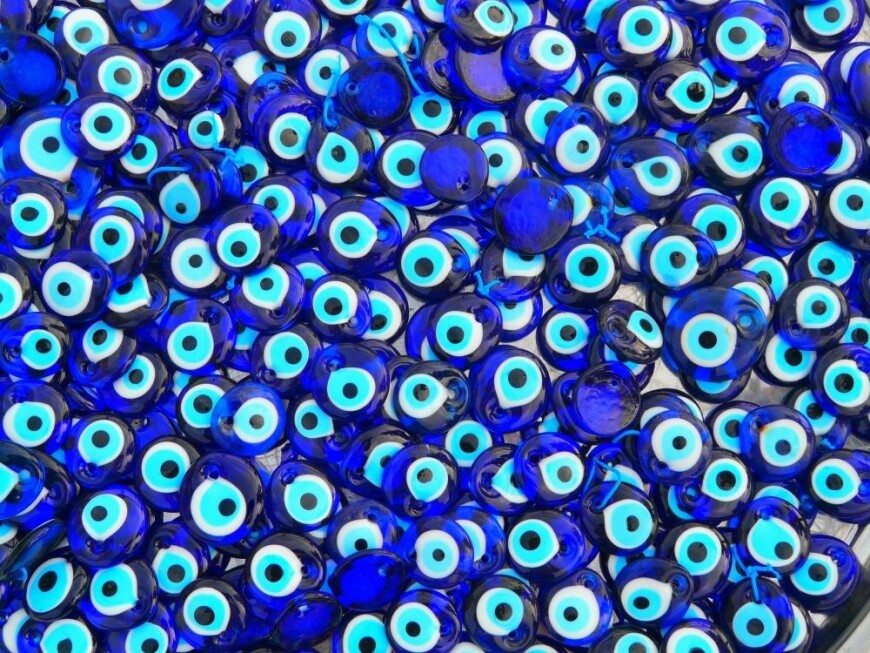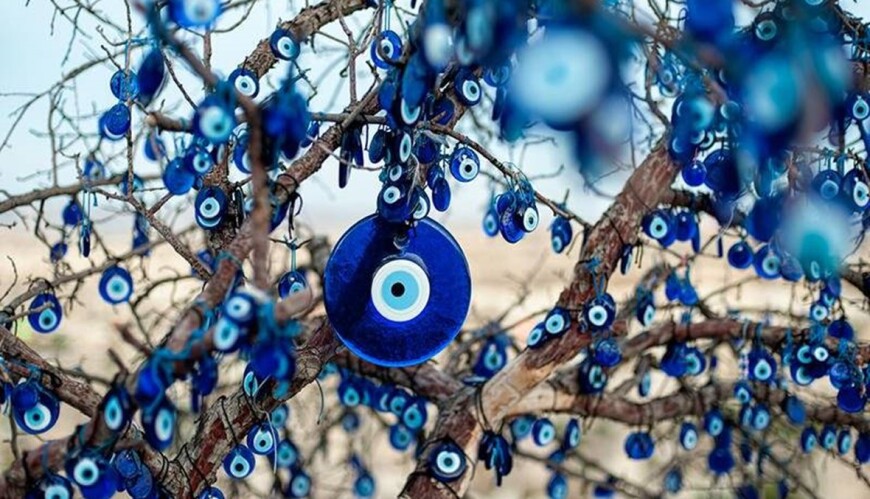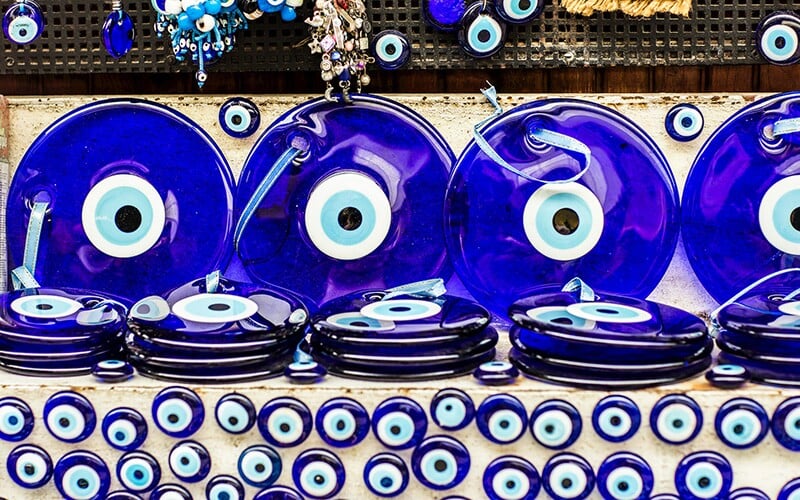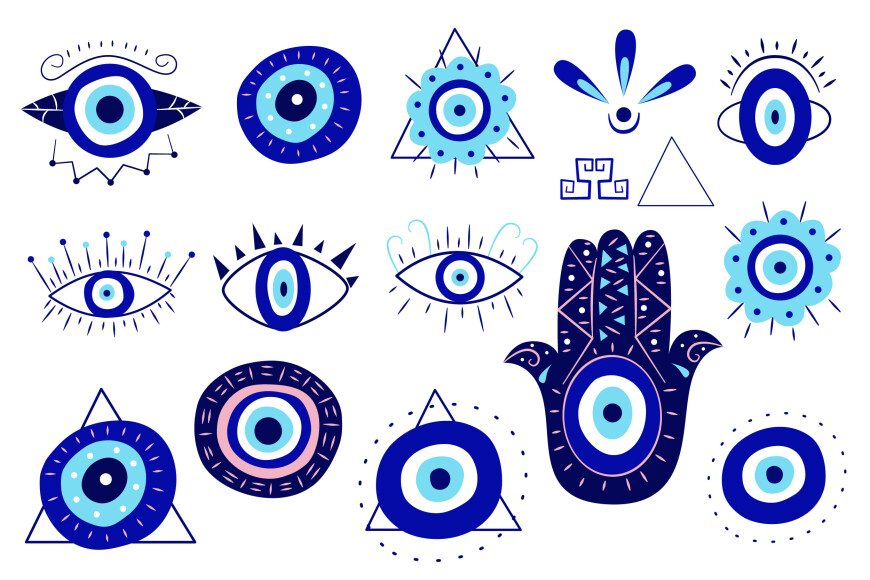Blue eyes or Nazar Boncugu in Turkish refers to a very traditional item in Turkey, it's a blue bead used as a talisman which is believed that it would protect you against the evil eye. The evil-eye superstition comes from very early times and it can be found in most of the cultures in the world. To prevent this unfortunate thing, Turks invented blue beads which look like an eye that looks straight back at the spell-caster. So Turkish blue eyes would guard you from any negative energy or from jealous looks of others for example.
Nazar boncugu originated in Turkey. Derived from Arabic terms, 'nazar' means 'sight' and 'boncuk', or 'boncugu', means beads. Thus, it’s a bead of the blue eye.
The Turkish type of the nazar boncugu depicts it as a circle of dark blue glass with 3 smaller circles set within it. These are white “eyeball”, light blue “iris”, and black “pupil” at the center. The Nazar bead has usually around shapes, but it comes in all sizes and all kinds of shapes and decorations; sometimes as a keychain, photo frame, bracelet, inscriptions, refrigerator magnet, and so on.
Turkish Blue Eyes
Turkish blue eyes are a cultural thing that has over 500 years of history and is still used all around the country, especially for a newborn baby, a brand new car, or even a newly built house to keep that bad energy away.
Actually, not only in Turkey, the Turkish evil blue eye can be seen on bracelets, necklaces, and other forms of jewelry almost across the entire world, especially among Jewish, Muslim, and Christian cultures. The jewelry shops aren't the only places where you'll see this symbol as a good number of Turkish people have it hanging up in their houses, shops, offices, and cars as a part of their life.
For example, if you go to Cappadocia in Turkey, you'll find these symbols even hanging at trees. This phenomenon is more than an aesthetic accessory, however. This has a fascinating history and meaning behind it.
Why is the Turkish Nazar Boncuk blue?
Turkish blue eyes are usually made of blue glass, with white and yellow or white and blue again circles inside, that would be a typical Turkish Nazar Boncuk. But there are other colors too, fashionable ones such as white color with blue circles inside. However, blue is always the traditional color of the Turkish nazar bead.
The blue color probably comes from the influence of the Byzantines. Blue was the color of heaven and water, it was sacred. It symbolized the infinite, the divine, the spiritual, and also evoked peace, calm.
Another belief that 'evil eye bead' or 'Evil eye bead' should be of blue color was probably influenced by Greek philosopher Plutarch, who said that those best at delivering the evil eye curse were blue-eyed. Also, it is likely because blue eyes are a genetic rarity in the Mediterranean area. In the other hand, the depiction of blue Eye of Horus discovered in Egypt and the connection of the color itself with Tengri, a sky deity of ancient Turks and Mongols, likely influenced the symbolism.

Different Color Turkish Nazar Boncugu
In many cultures that believe in the Nazar boncuk, the most popular color is blue. But over the years many other colors have come to symbolize different meanings. Here are some of the most popular colors that Nazar Boncuks are available in and the meanings behind them.
Red Nazar Boncuk:
- Gives Energy and Enthusiasm
- It encourages
- Protects from fear and anxiety
- Confidence to go after your dream
Orange Nazar Boncuk:
- For protection and happiness
- Increases playfulness and creativity
- Provides motivation and commitment
White Nazar Boncuk:
- Brings about mental clarity
- Clears obstacles
- Gives focus and purity
- Starts a fresh beginning
Pink Nazar Boncuk:
- Provides relaxation
- Neutralizes disorder
- Friendship protection
- Gives a calming feeling
Dark green Nazar Boncuk:
- Brings balance to your life
- Promotes happiness
- Gives the freedom to chase new dreams
- Increases personal power
Purple Nazar Boncuk:
- Removes obstacles in the path
- Boosts imagination
- Re-balances your life
Yellow or Gold Nazar Boncuk:
- Protects your health
- Reliefs from exhaustion and panic
- Sharper mind and concentration

History of the Evil Blue Eyes
Almost every civilization has attempted to express evil blue eyes using amulets such as Turkey use Nazar Boncugu.
Evil Blue Eyes in Different Cultures
Across the World, various cultures and countries have witnessed the appearance of the evil eye and its negative impacts. In every culture, the evil eye has been explained in multiple terms. Here is everything you need to know about this evil eye curse and its protection rituals.
Blue Evil Eye in Turkey
In Turkey, the blue evil eye protection charm is known as Nazar Boncuk. It is an ancient talisman made with glass or crystal consisting of dark blue or light blue concentric circles with yellow, white, and black eye dots in the center.

Blue Evil Eye in Greece
Blue Evil Eye in England, Scotland and Ireland
Blue Evil Eye in Italy

Blue Evil Eye in Spain and Latin America (Mexico, Puerto Rico, Guatemala)
Turkish Blue Eyes Meaning
Tolerance Homes
We are always ready to answer all your questions, please reach out via Whatsapp +90 (532) 158 42 44
If you want to emigrate or buy an apartment in Turkey or own a property in turkey and enjoy life by the sea, message our specialists who will find the best options for your budget.
Also, subscribe to our YouTube channel and Instagram page to receive information from the professionals!
An additional channel to connect with us: Telegram

